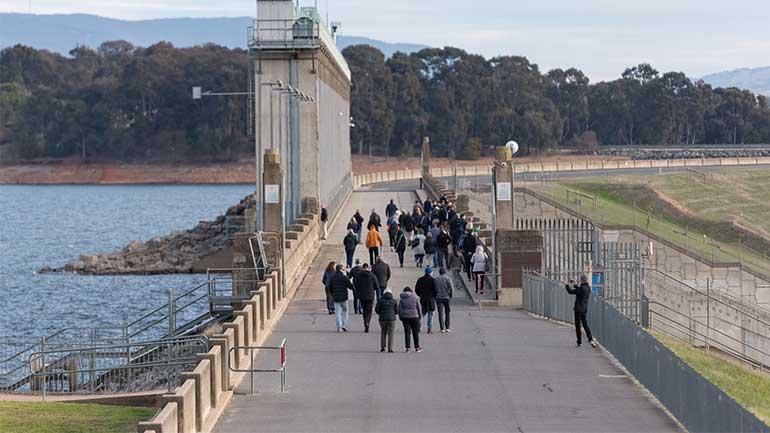Hume Dam, located near the junction of the Murray and Mitta Mitta rivers, serves as the key storage point for the River Murray system. Situated 16 kilometres east of Albury on the New South Wales-Victorian border, its primary function is to store, regulate and manage water for both human use and environmental conservation.
During the visit, tour members enjoyed scenic views of Lake Hume and the River Murray from the 318-metre spillway, which regulates water flow from the reservoir.

Representatives from the Murray–Darling Basin Authority (MDBA) and WaterNSW conducted an educational session, explaining the complexities of managing this significant water infrastructure asset.
The discussion covered the operations of Hume Dam, the various roles involved in managing water resources, delivery schedules, and the climate adaptation work that is being done to mitigate the impacts on water quality.

Participants raised numerous questions about climate change and its potential future impacts on the health of the river system.
One key question focused on how climate change could affect the longevity and reliability of Hume Dam and other vital water infrastructure across the Basin.
While the design life of these assets range from about 100 to 150 years, we expect they’ll perform for long beyond that. Of course that won’t be achievable without ongoing maintenance and renewal works – similar to what has been done here at Hume Dam in the past. Like many aspects of water management, we will have to keep researching how these large pieces of infrastructure will be impacted by climate change and adapt accordingly.
– Angus Paton, Murray–Darling Basin Authority
The group visited the dam in June, during the winter-spring period when downstream water needs are typically lower and upstream water inflows are higher. This time of year sees about 80% of the annual water inflow, allowing the dam's storage to increase.
Looking out at the large amount of water held behind the dam wall, many attendees were surprised to discover that the dam was less than 70% full during the tour.
Hume Dam holds a maximum of 3,005 GL. This is approximately 6 times the volume of Sydney Harbour.
| Fill phase (current) | Spill phase | Supply phase |
| Inflows are stored to replenish the storage volume. | On average, Hume Reservoir spills about 1 year in 2. | Begins when demand-driven releases of water exceed the inflows. |
| Filling generally takes place during winter and spring when downstream demands are at their lowest and upstream inflows increase. | When likelihood of spilling increases, operations move into the spill phase. In this phase, managing 'airspace' is a focus and floods may occur. | Typically begins between August and November, and continues until May in the following year. Storage is usually drawn down to between 10% and 50% of its capacity by the end of autumn. |
What is the purpose of the dam?
Hume Dam plays a crucial role in managing flows and securing water supplies along the entire River Murray system. In conjunction with downstream tributary flows, releases from Hume Dam also supply water along the Murray to New South Wales, Victoria and South Australia to support:
- irrigated agriculture
- stock and domestic water supply
- hydro-electric power generation
- recreation and tourism.
Water being released into the River Murray from Hume Dam
Who manages the dam?
Working out how to provide sufficient water, whilst operating efficiently is one of the primary challenges of managing infrastructure in the Murray–Darling Basin. To ensure flows are controlled and water is supplied and stored effectively, these assets (including Hume Dam) are managed collaboratively between the Australian Government and the states of New South Wales, Victoria and South Australia.
The Murray–Darling Basin Authority directs the operation of the structure.
The MDBA’s role is to work with WaterNSW and the NSW Government to follow asset management principles to improve the sustainability of the dam. These principles range from day-to-day operation and maintenance, to determining the most effective solutions to meeting customer needs. The MDBA also oversees the investigation, design, construction, operation and maintenance of existing and future major engineering structures or works.
How long does water take to get delivered downstream?
The River Murray is Australia's longest river, running a course of 2,500 kilometres from near Mount Kosciuszko in the Australian Alps to the Southern Ocean at Goolwa in South Australia. Understanding how water travels through the system, and how long it can take to get from one place to another is complex. Planning and timing of releases for water supply is complicated, and travel times can vary significantly based on a range of factors.
Travel times for water from Hume Dam to locations downstream can range between several days and several weeks.
Management of water quality
Water quality and water availability must be carefully managed to ensure the Basin stays healthy, now and in the future. Water quality is managed in partnership by the Australian Government and the Basin state governments. The MDBA’s role is to set out water quality targets, while Basin states and agencies are responsible for the monitoring and management of the quality of the water.
Water quality at Hume Dam is monitored and managed by WaterNSW.
For more information about who we work with, and how water is managed to protect our rivers for generations, explore water management.